NURSING 8: Case Study on Hypovolemic Shock and Patient Deterioration
VerifiedAdded on 2022/11/13
|13
|3070
|340
Case Study
AI Summary
This case study focuses on Kenneth Bradman, a 67-year-old patient admitted to the surgical high dependency unit due to per rectum bleeding, leading to hypovolemic shock. The assignment analyzes the patient's clinical deterioration, identifying labored breathing and increased heart rate as key symptoms. The primary problem is identified as deficient fluid volume, and the essay proposes two crucial nursing interventions: crystalloid fluid infusion combined with vasoactive medications and blood transfusions. Furthermore, the study addresses potential psychosocial issues, including the patient's alcohol consumption and imprisonment, recommending family counseling and patient education. The study emphasizes the importance of early recognition of clinical deterioration and prompt implementation of appropriate nursing interventions to stabilize the patient's condition and improve outcomes.
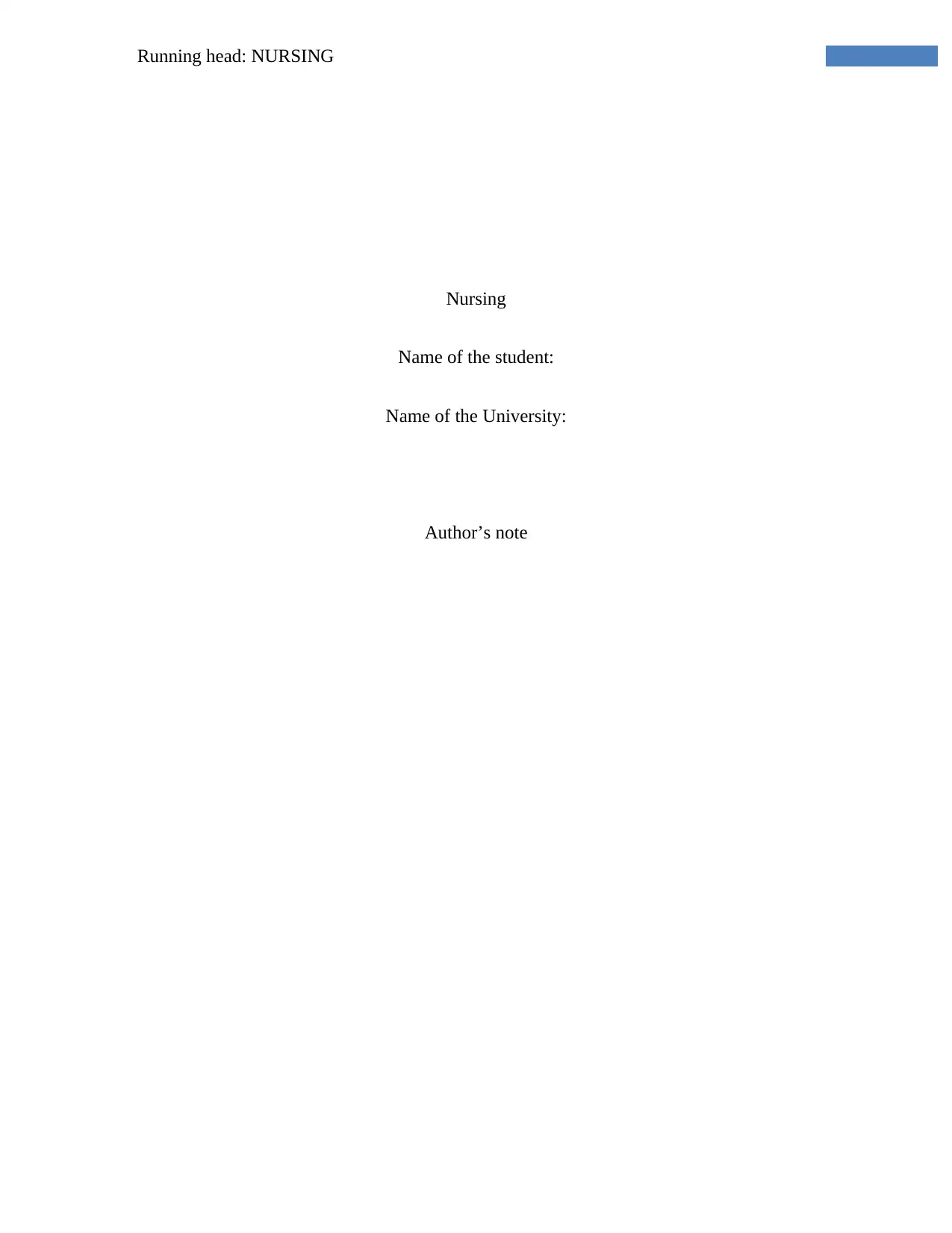
Running head: NURSING
Nursing
Name of the student:
Name of the University:
Author’s note
Nursing
Name of the student:
Name of the University:
Author’s note
Paraphrase This Document
Need a fresh take? Get an instant paraphrase of this document with our AI Paraphraser
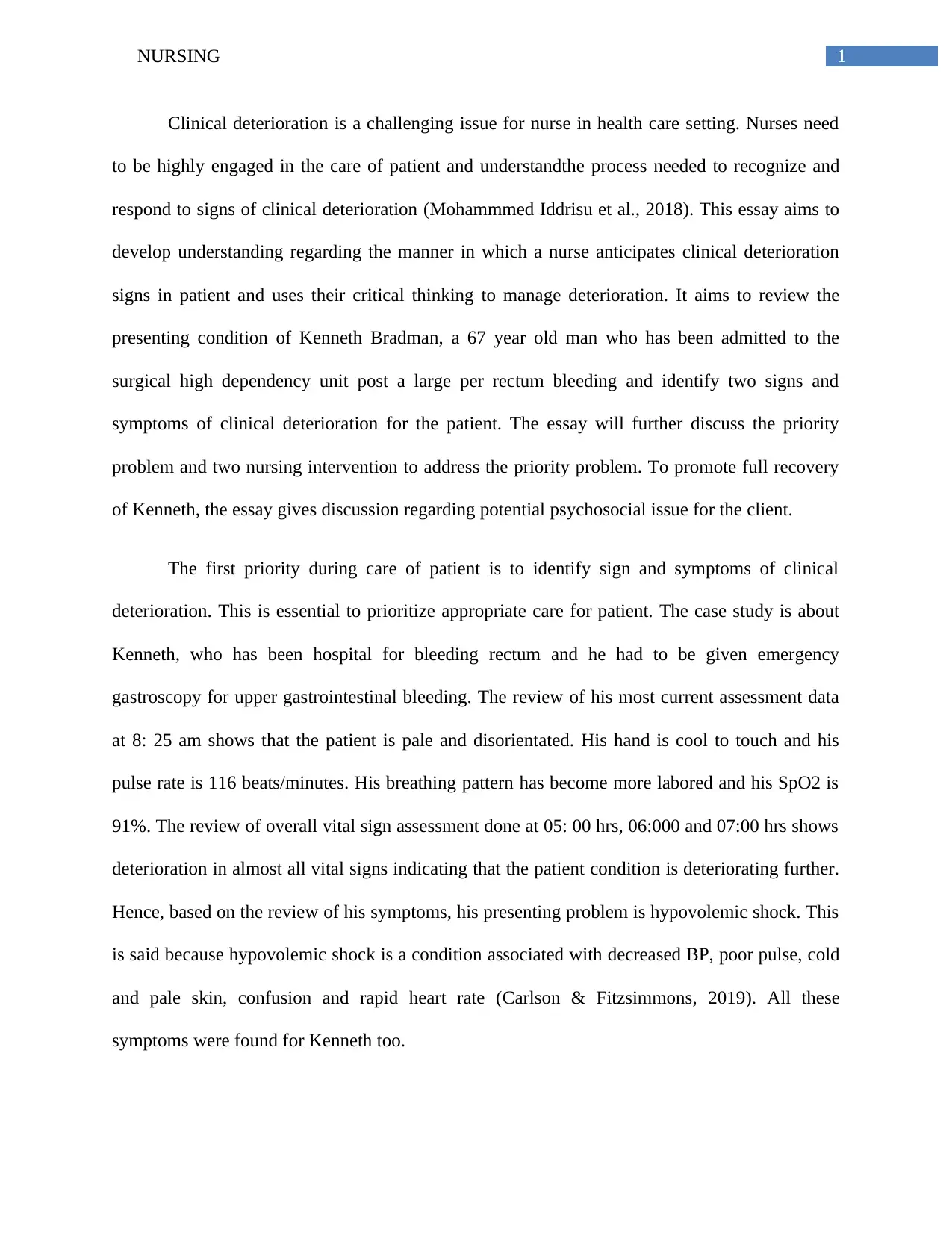
1NURSING
Clinical deterioration is a challenging issue for nurse in health care setting. Nurses need
to be highly engaged in the care of patient and understandthe process needed to recognize and
respond to signs of clinical deterioration (Mohammmed Iddrisu et al., 2018). This essay aims to
develop understanding regarding the manner in which a nurse anticipates clinical deterioration
signs in patient and uses their critical thinking to manage deterioration. It aims to review the
presenting condition of Kenneth Bradman, a 67 year old man who has been admitted to the
surgical high dependency unit post a large per rectum bleeding and identify two signs and
symptoms of clinical deterioration for the patient. The essay will further discuss the priority
problem and two nursing intervention to address the priority problem. To promote full recovery
of Kenneth, the essay gives discussion regarding potential psychosocial issue for the client.
The first priority during care of patient is to identify sign and symptoms of clinical
deterioration. This is essential to prioritize appropriate care for patient. The case study is about
Kenneth, who has been hospital for bleeding rectum and he had to be given emergency
gastroscopy for upper gastrointestinal bleeding. The review of his most current assessment data
at 8: 25 am shows that the patient is pale and disorientated. His hand is cool to touch and his
pulse rate is 116 beats/minutes. His breathing pattern has become more labored and his SpO2 is
91%. The review of overall vital sign assessment done at 05: 00 hrs, 06:000 and 07:00 hrs shows
deterioration in almost all vital signs indicating that the patient condition is deteriorating further.
Hence, based on the review of his symptoms, his presenting problem is hypovolemic shock. This
is said because hypovolemic shock is a condition associated with decreased BP, poor pulse, cold
and pale skin, confusion and rapid heart rate (Carlson & Fitzsimmons, 2019). All these
symptoms were found for Kenneth too.
Clinical deterioration is a challenging issue for nurse in health care setting. Nurses need
to be highly engaged in the care of patient and understandthe process needed to recognize and
respond to signs of clinical deterioration (Mohammmed Iddrisu et al., 2018). This essay aims to
develop understanding regarding the manner in which a nurse anticipates clinical deterioration
signs in patient and uses their critical thinking to manage deterioration. It aims to review the
presenting condition of Kenneth Bradman, a 67 year old man who has been admitted to the
surgical high dependency unit post a large per rectum bleeding and identify two signs and
symptoms of clinical deterioration for the patient. The essay will further discuss the priority
problem and two nursing intervention to address the priority problem. To promote full recovery
of Kenneth, the essay gives discussion regarding potential psychosocial issue for the client.
The first priority during care of patient is to identify sign and symptoms of clinical
deterioration. This is essential to prioritize appropriate care for patient. The case study is about
Kenneth, who has been hospital for bleeding rectum and he had to be given emergency
gastroscopy for upper gastrointestinal bleeding. The review of his most current assessment data
at 8: 25 am shows that the patient is pale and disorientated. His hand is cool to touch and his
pulse rate is 116 beats/minutes. His breathing pattern has become more labored and his SpO2 is
91%. The review of overall vital sign assessment done at 05: 00 hrs, 06:000 and 07:00 hrs shows
deterioration in almost all vital signs indicating that the patient condition is deteriorating further.
Hence, based on the review of his symptoms, his presenting problem is hypovolemic shock. This
is said because hypovolemic shock is a condition associated with decreased BP, poor pulse, cold
and pale skin, confusion and rapid heart rate (Carlson & Fitzsimmons, 2019). All these
symptoms were found for Kenneth too.
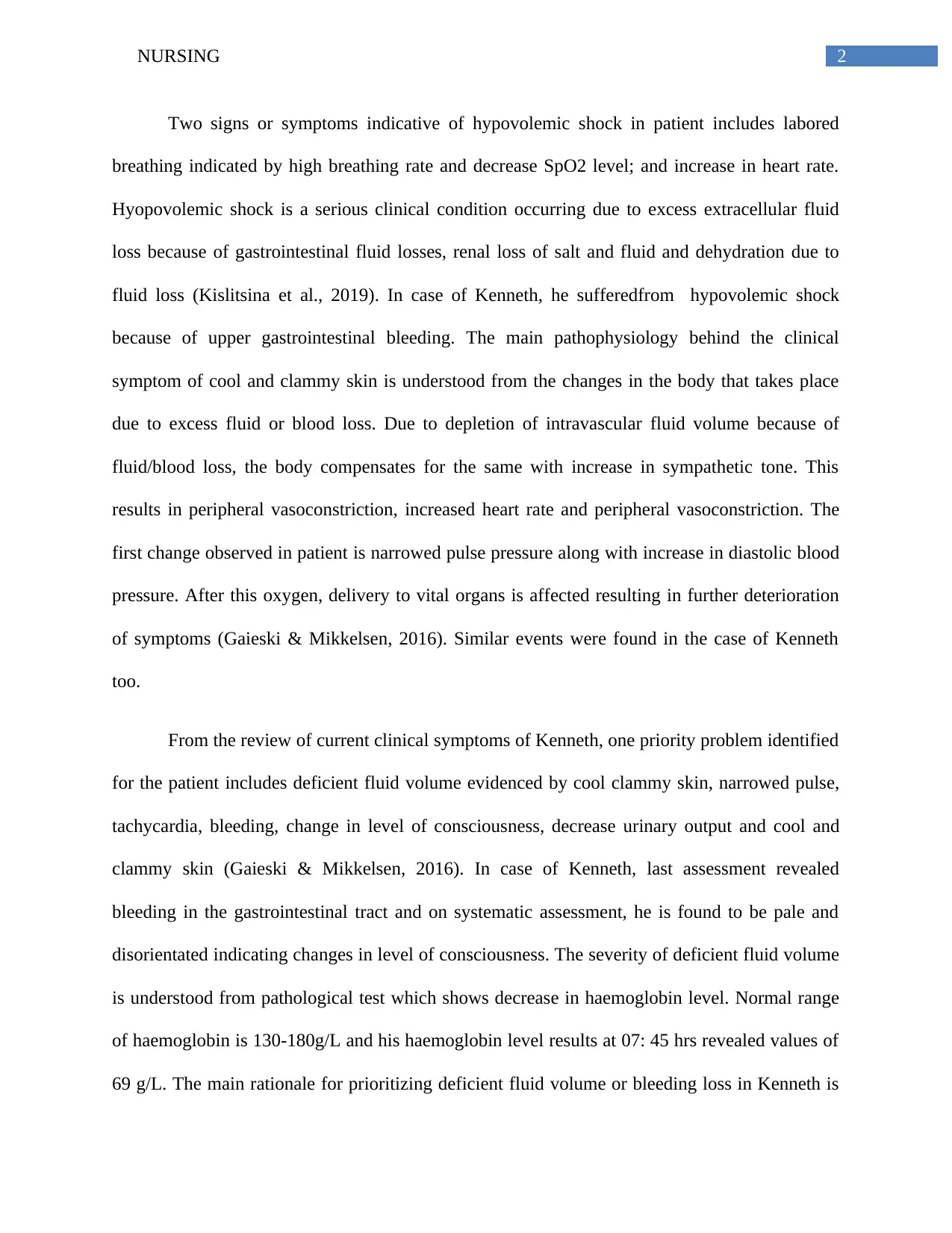
2NURSING
Two signs or symptoms indicative of hypovolemic shock in patient includes labored
breathing indicated by high breathing rate and decrease SpO2 level; and increase in heart rate.
Hyopovolemic shock is a serious clinical condition occurring due to excess extracellular fluid
loss because of gastrointestinal fluid losses, renal loss of salt and fluid and dehydration due to
fluid loss (Kislitsina et al., 2019). In case of Kenneth, he sufferedfrom hypovolemic shock
because of upper gastrointestinal bleeding. The main pathophysiology behind the clinical
symptom of cool and clammy skin is understood from the changes in the body that takes place
due to excess fluid or blood loss. Due to depletion of intravascular fluid volume because of
fluid/blood loss, the body compensates for the same with increase in sympathetic tone. This
results in peripheral vasoconstriction, increased heart rate and peripheral vasoconstriction. The
first change observed in patient is narrowed pulse pressure along with increase in diastolic blood
pressure. After this oxygen, delivery to vital organs is affected resulting in further deterioration
of symptoms (Gaieski & Mikkelsen, 2016). Similar events were found in the case of Kenneth
too.
From the review of current clinical symptoms of Kenneth, one priority problem identified
for the patient includes deficient fluid volume evidenced by cool clammy skin, narrowed pulse,
tachycardia, bleeding, change in level of consciousness, decrease urinary output and cool and
clammy skin (Gaieski & Mikkelsen, 2016). In case of Kenneth, last assessment revealed
bleeding in the gastrointestinal tract and on systematic assessment, he is found to be pale and
disorientated indicating changes in level of consciousness. The severity of deficient fluid volume
is understood from pathological test which shows decrease in haemoglobin level. Normal range
of haemoglobin is 130-180g/L and his haemoglobin level results at 07: 45 hrs revealed values of
69 g/L. The main rationale for prioritizing deficient fluid volume or bleeding loss in Kenneth is
Two signs or symptoms indicative of hypovolemic shock in patient includes labored
breathing indicated by high breathing rate and decrease SpO2 level; and increase in heart rate.
Hyopovolemic shock is a serious clinical condition occurring due to excess extracellular fluid
loss because of gastrointestinal fluid losses, renal loss of salt and fluid and dehydration due to
fluid loss (Kislitsina et al., 2019). In case of Kenneth, he sufferedfrom hypovolemic shock
because of upper gastrointestinal bleeding. The main pathophysiology behind the clinical
symptom of cool and clammy skin is understood from the changes in the body that takes place
due to excess fluid or blood loss. Due to depletion of intravascular fluid volume because of
fluid/blood loss, the body compensates for the same with increase in sympathetic tone. This
results in peripheral vasoconstriction, increased heart rate and peripheral vasoconstriction. The
first change observed in patient is narrowed pulse pressure along with increase in diastolic blood
pressure. After this oxygen, delivery to vital organs is affected resulting in further deterioration
of symptoms (Gaieski & Mikkelsen, 2016). Similar events were found in the case of Kenneth
too.
From the review of current clinical symptoms of Kenneth, one priority problem identified
for the patient includes deficient fluid volume evidenced by cool clammy skin, narrowed pulse,
tachycardia, bleeding, change in level of consciousness, decrease urinary output and cool and
clammy skin (Gaieski & Mikkelsen, 2016). In case of Kenneth, last assessment revealed
bleeding in the gastrointestinal tract and on systematic assessment, he is found to be pale and
disorientated indicating changes in level of consciousness. The severity of deficient fluid volume
is understood from pathological test which shows decrease in haemoglobin level. Normal range
of haemoglobin is 130-180g/L and his haemoglobin level results at 07: 45 hrs revealed values of
69 g/L. The main rationale for prioritizing deficient fluid volume or bleeding loss in Kenneth is
⊘ This is a preview!⊘
Do you want full access?
Subscribe today to unlock all pages.

Trusted by 1+ million students worldwide

3NURSING
that it is the primary condition that leads to initiation of changes in the body of patient
(Ratnasekera, Reilly & Ferrada, 2018).
Decreased fluid volume leads to reduced blood return to the heart contributing to low
cardiac output. This in turn increases the heart rate and increases systematic vascular resistance
and tissue perfusion pressure. In later shock stage, blood volume rises and urine output decreases
(Gulati, 2016). Hence, uncorrected hypovolemia can be fatal and addressing decreased fluid
volume is most crucial to reduce further deteriorations in vital signs of patient. As Kenneth
experience hypovolemic shock because of decrease in blood volume due to excessive bleeding,
leaving the patient untreated may lead to hypoxic tissue damage, organ failure and ultimately
death (Mandal, 2016). Therefore restoring fluid volume is most crucial to save life of patient and
stabilise the condition of patient.
In response to the problem of deficient fluid volume due to bleeding and its impact on
deterioration of vital signs of Kenneth, two nursing intervention that is vital to stabilize the
patient condition includes administering crystalloid fluid in conjunction with vasoactive
medications and blood transfusion. Use of crystalloid is the first fluid of choice for resuscitation
of patient who experience hypovolemic shock due to blood loss (Walley, 2018). In addition,
vasoactive agents like dopamine can help to increase blood pressure of patient. The two
interventions have been prioritized considering the past medical history of patient too. Kenneth is
a patient with chronic kidney disease and hypertension. Hence, low fluid volume due to fluid
volume can have many negative complications on his kidney functions and blood pressure
(Feehally & Khosravi, 2015). Therefore, to prevent problem in blood circulation and kidney
function, crystalloid infusion is important to restore fluid and vasoactive medication is necessary
to control blood pressure respectively.
that it is the primary condition that leads to initiation of changes in the body of patient
(Ratnasekera, Reilly & Ferrada, 2018).
Decreased fluid volume leads to reduced blood return to the heart contributing to low
cardiac output. This in turn increases the heart rate and increases systematic vascular resistance
and tissue perfusion pressure. In later shock stage, blood volume rises and urine output decreases
(Gulati, 2016). Hence, uncorrected hypovolemia can be fatal and addressing decreased fluid
volume is most crucial to reduce further deteriorations in vital signs of patient. As Kenneth
experience hypovolemic shock because of decrease in blood volume due to excessive bleeding,
leaving the patient untreated may lead to hypoxic tissue damage, organ failure and ultimately
death (Mandal, 2016). Therefore restoring fluid volume is most crucial to save life of patient and
stabilise the condition of patient.
In response to the problem of deficient fluid volume due to bleeding and its impact on
deterioration of vital signs of Kenneth, two nursing intervention that is vital to stabilize the
patient condition includes administering crystalloid fluid in conjunction with vasoactive
medications and blood transfusion. Use of crystalloid is the first fluid of choice for resuscitation
of patient who experience hypovolemic shock due to blood loss (Walley, 2018). In addition,
vasoactive agents like dopamine can help to increase blood pressure of patient. The two
interventions have been prioritized considering the past medical history of patient too. Kenneth is
a patient with chronic kidney disease and hypertension. Hence, low fluid volume due to fluid
volume can have many negative complications on his kidney functions and blood pressure
(Feehally & Khosravi, 2015). Therefore, to prevent problem in blood circulation and kidney
function, crystalloid infusion is important to restore fluid and vasoactive medication is necessary
to control blood pressure respectively.
Paraphrase This Document
Need a fresh take? Get an instant paraphrase of this document with our AI Paraphraser
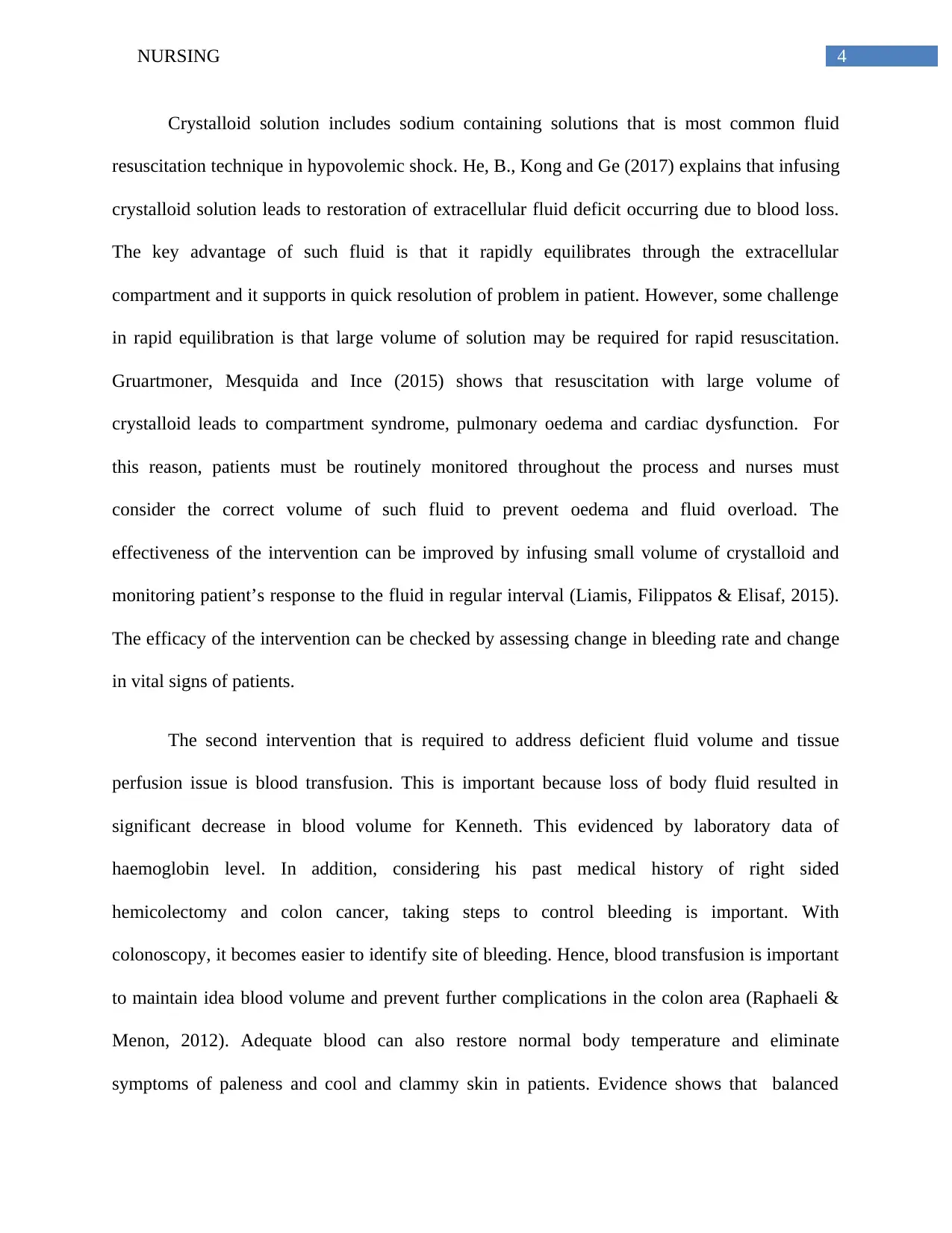
4NURSING
Crystalloid solution includes sodium containing solutions that is most common fluid
resuscitation technique in hypovolemic shock. He, B., Kong and Ge (2017) explains that infusing
crystalloid solution leads to restoration of extracellular fluid deficit occurring due to blood loss.
The key advantage of such fluid is that it rapidly equilibrates through the extracellular
compartment and it supports in quick resolution of problem in patient. However, some challenge
in rapid equilibration is that large volume of solution may be required for rapid resuscitation.
Gruartmoner, Mesquida and Ince (2015) shows that resuscitation with large volume of
crystalloid leads to compartment syndrome, pulmonary oedema and cardiac dysfunction. For
this reason, patients must be routinely monitored throughout the process and nurses must
consider the correct volume of such fluid to prevent oedema and fluid overload. The
effectiveness of the intervention can be improved by infusing small volume of crystalloid and
monitoring patient’s response to the fluid in regular interval (Liamis, Filippatos & Elisaf, 2015).
The efficacy of the intervention can be checked by assessing change in bleeding rate and change
in vital signs of patients.
The second intervention that is required to address deficient fluid volume and tissue
perfusion issue is blood transfusion. This is important because loss of body fluid resulted in
significant decrease in blood volume for Kenneth. This evidenced by laboratory data of
haemoglobin level. In addition, considering his past medical history of right sided
hemicolectomy and colon cancer, taking steps to control bleeding is important. With
colonoscopy, it becomes easier to identify site of bleeding. Hence, blood transfusion is important
to maintain idea blood volume and prevent further complications in the colon area (Raphaeli &
Menon, 2012). Adequate blood can also restore normal body temperature and eliminate
symptoms of paleness and cool and clammy skin in patients. Evidence shows that balanced
Crystalloid solution includes sodium containing solutions that is most common fluid
resuscitation technique in hypovolemic shock. He, B., Kong and Ge (2017) explains that infusing
crystalloid solution leads to restoration of extracellular fluid deficit occurring due to blood loss.
The key advantage of such fluid is that it rapidly equilibrates through the extracellular
compartment and it supports in quick resolution of problem in patient. However, some challenge
in rapid equilibration is that large volume of solution may be required for rapid resuscitation.
Gruartmoner, Mesquida and Ince (2015) shows that resuscitation with large volume of
crystalloid leads to compartment syndrome, pulmonary oedema and cardiac dysfunction. For
this reason, patients must be routinely monitored throughout the process and nurses must
consider the correct volume of such fluid to prevent oedema and fluid overload. The
effectiveness of the intervention can be improved by infusing small volume of crystalloid and
monitoring patient’s response to the fluid in regular interval (Liamis, Filippatos & Elisaf, 2015).
The efficacy of the intervention can be checked by assessing change in bleeding rate and change
in vital signs of patients.
The second intervention that is required to address deficient fluid volume and tissue
perfusion issue is blood transfusion. This is important because loss of body fluid resulted in
significant decrease in blood volume for Kenneth. This evidenced by laboratory data of
haemoglobin level. In addition, considering his past medical history of right sided
hemicolectomy and colon cancer, taking steps to control bleeding is important. With
colonoscopy, it becomes easier to identify site of bleeding. Hence, blood transfusion is important
to maintain idea blood volume and prevent further complications in the colon area (Raphaeli &
Menon, 2012). Adequate blood can also restore normal body temperature and eliminate
symptoms of paleness and cool and clammy skin in patients. Evidence shows that balanced

5NURSING
transfusion using 1:1:1 ratio of plasma to platelet to packed red blood cell is effective in restoring
homeostasis is effective in achieving better outcomes for patient with hypovolemic shock
(Taghavi & Askari, 2018). The WHO guidelines recommends that as blood transfusion carries
risk of adverse reactions, use of blood and blood products in any clinical situation should be
considered only to treat significant morbidity or mortality related issues (World Health
Organization, 2019). To promote efficacy of the treatment, it is necessary for nurse to assess
haemoglobin and hematocrit value of Kenneth to get an idea about patient’s response to
transfusions. This can be done by regular blood test.
Apart from severe changes in clinical symptoms of patient, one psychosocial issue that
has been found for Kenneth includes excessive use of ethanol evidenced by consumption of more
than 10 standards drinks per day. Another issue is that the patient is in imprisonment. Hence, his
imprisonment might be reason behind occurrence of his gastrointestinal illness as such places are
prone to infection (Alves, Maia & Teixeira, 2016). However, considering his present condition
of health, prolonged imprisonment can further increase risk of infection and make patient
vulnerable to poor nutritional and psychological outcomes. Being in imprison can be a source for
worry for family members too as they will find it difficult to provide timely care to Kenneth.
Hence, to ensure patient centred care, it is necessary to assess Kenneth’s mental state due to his
current health and understand his preference in relation to care. In addition, conversation with
Kenneth’s family member is also necessary to understand whether they have any issue with
Kenneth staying at prison despite the deterioration of patient. On ground of this issue,
arrangement can be made so that Kenneth’s family members get the opportunity to visit him too.
In addition, providing educating regarding quitting alcohol is important as alcoholics often
underestimate risk of gastrointestinal bleeding and their consequences (Strate et al., 2016).
transfusion using 1:1:1 ratio of plasma to platelet to packed red blood cell is effective in restoring
homeostasis is effective in achieving better outcomes for patient with hypovolemic shock
(Taghavi & Askari, 2018). The WHO guidelines recommends that as blood transfusion carries
risk of adverse reactions, use of blood and blood products in any clinical situation should be
considered only to treat significant morbidity or mortality related issues (World Health
Organization, 2019). To promote efficacy of the treatment, it is necessary for nurse to assess
haemoglobin and hematocrit value of Kenneth to get an idea about patient’s response to
transfusions. This can be done by regular blood test.
Apart from severe changes in clinical symptoms of patient, one psychosocial issue that
has been found for Kenneth includes excessive use of ethanol evidenced by consumption of more
than 10 standards drinks per day. Another issue is that the patient is in imprisonment. Hence, his
imprisonment might be reason behind occurrence of his gastrointestinal illness as such places are
prone to infection (Alves, Maia & Teixeira, 2016). However, considering his present condition
of health, prolonged imprisonment can further increase risk of infection and make patient
vulnerable to poor nutritional and psychological outcomes. Being in imprison can be a source for
worry for family members too as they will find it difficult to provide timely care to Kenneth.
Hence, to ensure patient centred care, it is necessary to assess Kenneth’s mental state due to his
current health and understand his preference in relation to care. In addition, conversation with
Kenneth’s family member is also necessary to understand whether they have any issue with
Kenneth staying at prison despite the deterioration of patient. On ground of this issue,
arrangement can be made so that Kenneth’s family members get the opportunity to visit him too.
In addition, providing educating regarding quitting alcohol is important as alcoholics often
underestimate risk of gastrointestinal bleeding and their consequences (Strate et al., 2016).
⊘ This is a preview!⊘
Do you want full access?
Subscribe today to unlock all pages.

Trusted by 1+ million students worldwide
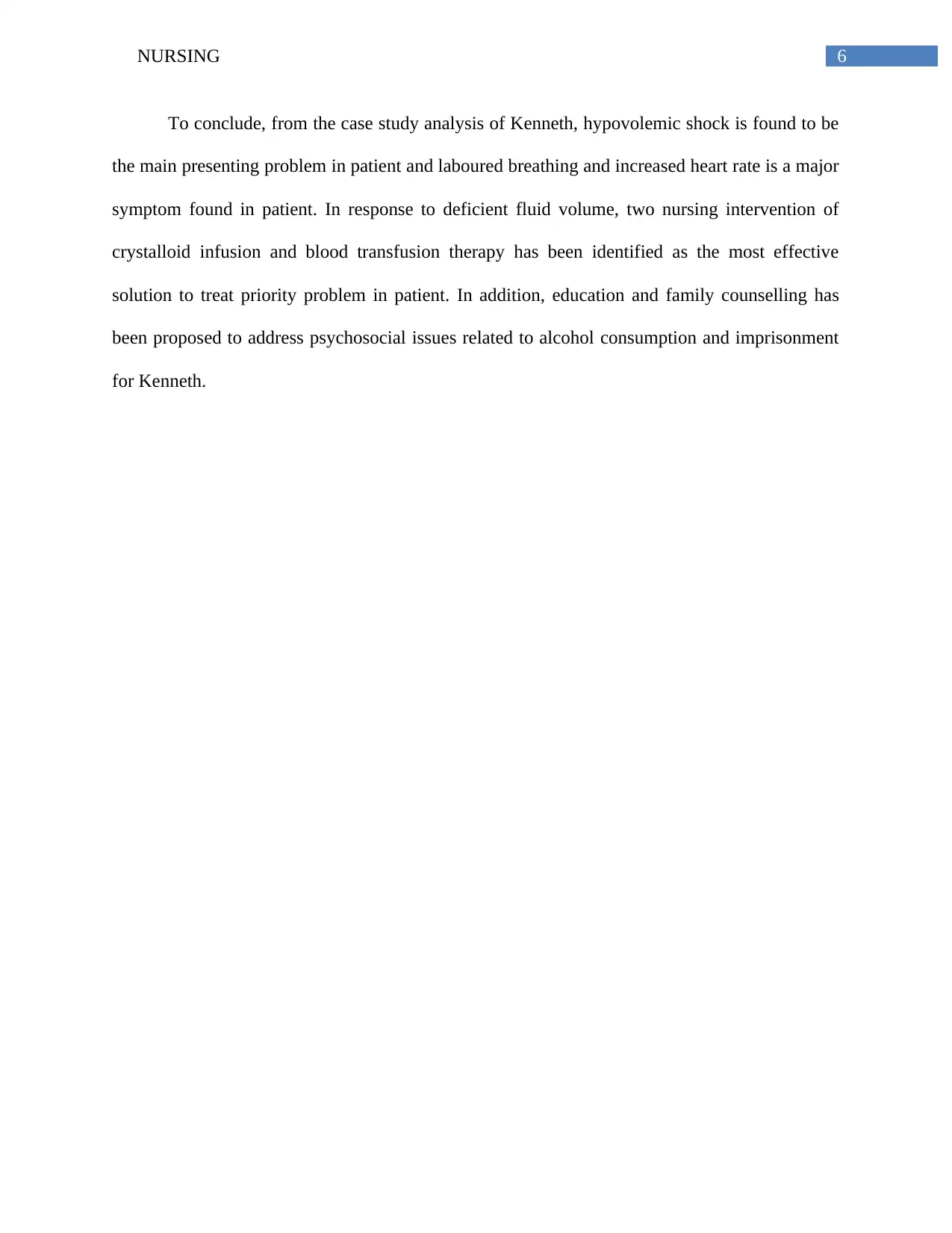
6NURSING
To conclude, from the case study analysis of Kenneth, hypovolemic shock is found to be
the main presenting problem in patient and laboured breathing and increased heart rate is a major
symptom found in patient. In response to deficient fluid volume, two nursing intervention of
crystalloid infusion and blood transfusion therapy has been identified as the most effective
solution to treat priority problem in patient. In addition, education and family counselling has
been proposed to address psychosocial issues related to alcohol consumption and imprisonment
for Kenneth.
To conclude, from the case study analysis of Kenneth, hypovolemic shock is found to be
the main presenting problem in patient and laboured breathing and increased heart rate is a major
symptom found in patient. In response to deficient fluid volume, two nursing intervention of
crystalloid infusion and blood transfusion therapy has been identified as the most effective
solution to treat priority problem in patient. In addition, education and family counselling has
been proposed to address psychosocial issues related to alcohol consumption and imprisonment
for Kenneth.
Paraphrase This Document
Need a fresh take? Get an instant paraphrase of this document with our AI Paraphraser
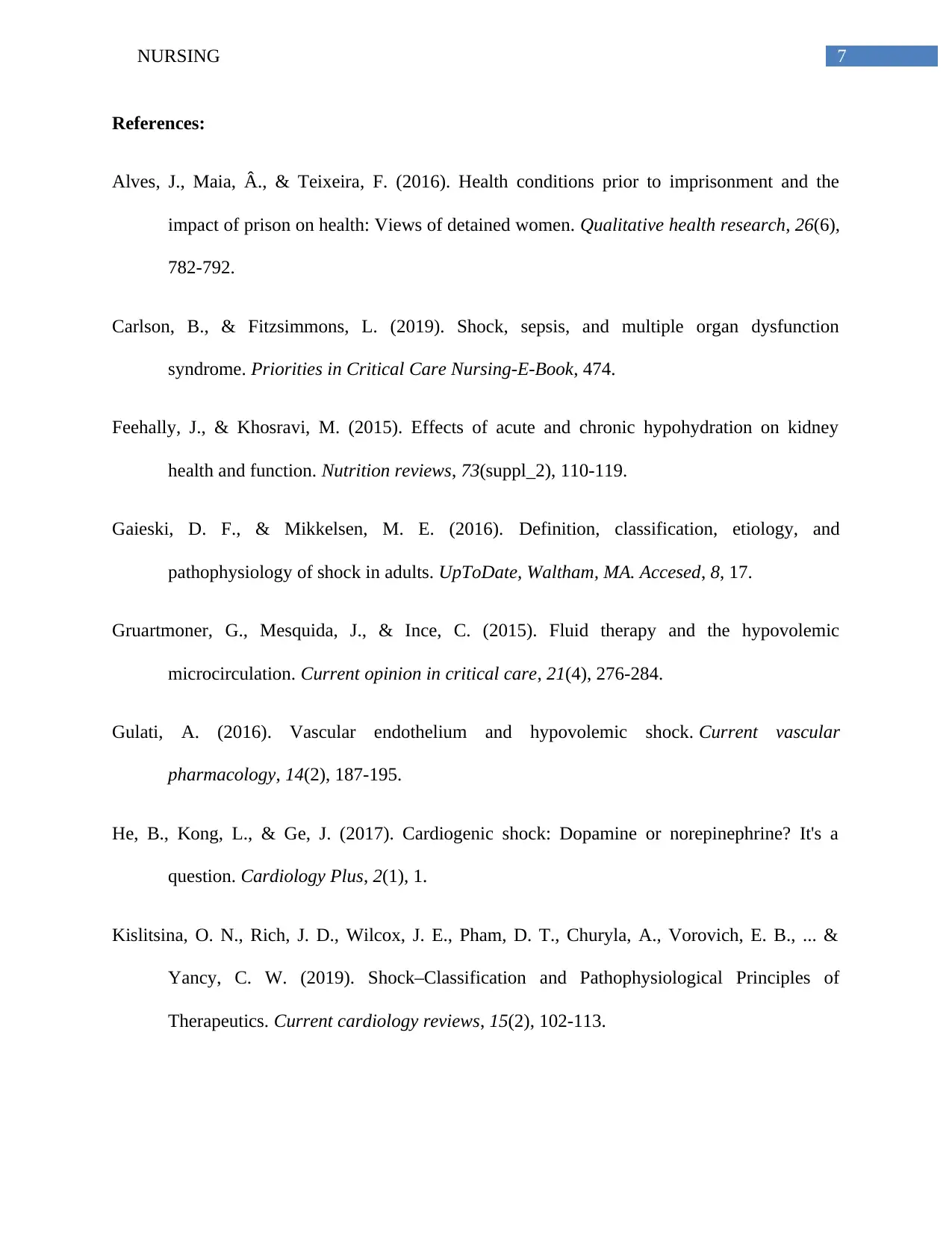
7NURSING
References:
Alves, J., Maia, Â., & Teixeira, F. (2016). Health conditions prior to imprisonment and the
impact of prison on health: Views of detained women. Qualitative health research, 26(6),
782-792.
Carlson, B., & Fitzsimmons, L. (2019). Shock, sepsis, and multiple organ dysfunction
syndrome. Priorities in Critical Care Nursing-E-Book, 474.
Feehally, J., & Khosravi, M. (2015). Effects of acute and chronic hypohydration on kidney
health and function. Nutrition reviews, 73(suppl_2), 110-119.
Gaieski, D. F., & Mikkelsen, M. E. (2016). Definition, classification, etiology, and
pathophysiology of shock in adults. UpToDate, Waltham, MA. Accesed, 8, 17.
Gruartmoner, G., Mesquida, J., & Ince, C. (2015). Fluid therapy and the hypovolemic
microcirculation. Current opinion in critical care, 21(4), 276-284.
Gulati, A. (2016). Vascular endothelium and hypovolemic shock. Current vascular
pharmacology, 14(2), 187-195.
He, B., Kong, L., & Ge, J. (2017). Cardiogenic shock: Dopamine or norepinephrine? It's a
question. Cardiology Plus, 2(1), 1.
Kislitsina, O. N., Rich, J. D., Wilcox, J. E., Pham, D. T., Churyla, A., Vorovich, E. B., ... &
Yancy, C. W. (2019). Shock–Classification and Pathophysiological Principles of
Therapeutics. Current cardiology reviews, 15(2), 102-113.
References:
Alves, J., Maia, Â., & Teixeira, F. (2016). Health conditions prior to imprisonment and the
impact of prison on health: Views of detained women. Qualitative health research, 26(6),
782-792.
Carlson, B., & Fitzsimmons, L. (2019). Shock, sepsis, and multiple organ dysfunction
syndrome. Priorities in Critical Care Nursing-E-Book, 474.
Feehally, J., & Khosravi, M. (2015). Effects of acute and chronic hypohydration on kidney
health and function. Nutrition reviews, 73(suppl_2), 110-119.
Gaieski, D. F., & Mikkelsen, M. E. (2016). Definition, classification, etiology, and
pathophysiology of shock in adults. UpToDate, Waltham, MA. Accesed, 8, 17.
Gruartmoner, G., Mesquida, J., & Ince, C. (2015). Fluid therapy and the hypovolemic
microcirculation. Current opinion in critical care, 21(4), 276-284.
Gulati, A. (2016). Vascular endothelium and hypovolemic shock. Current vascular
pharmacology, 14(2), 187-195.
He, B., Kong, L., & Ge, J. (2017). Cardiogenic shock: Dopamine or norepinephrine? It's a
question. Cardiology Plus, 2(1), 1.
Kislitsina, O. N., Rich, J. D., Wilcox, J. E., Pham, D. T., Churyla, A., Vorovich, E. B., ... &
Yancy, C. W. (2019). Shock–Classification and Pathophysiological Principles of
Therapeutics. Current cardiology reviews, 15(2), 102-113.
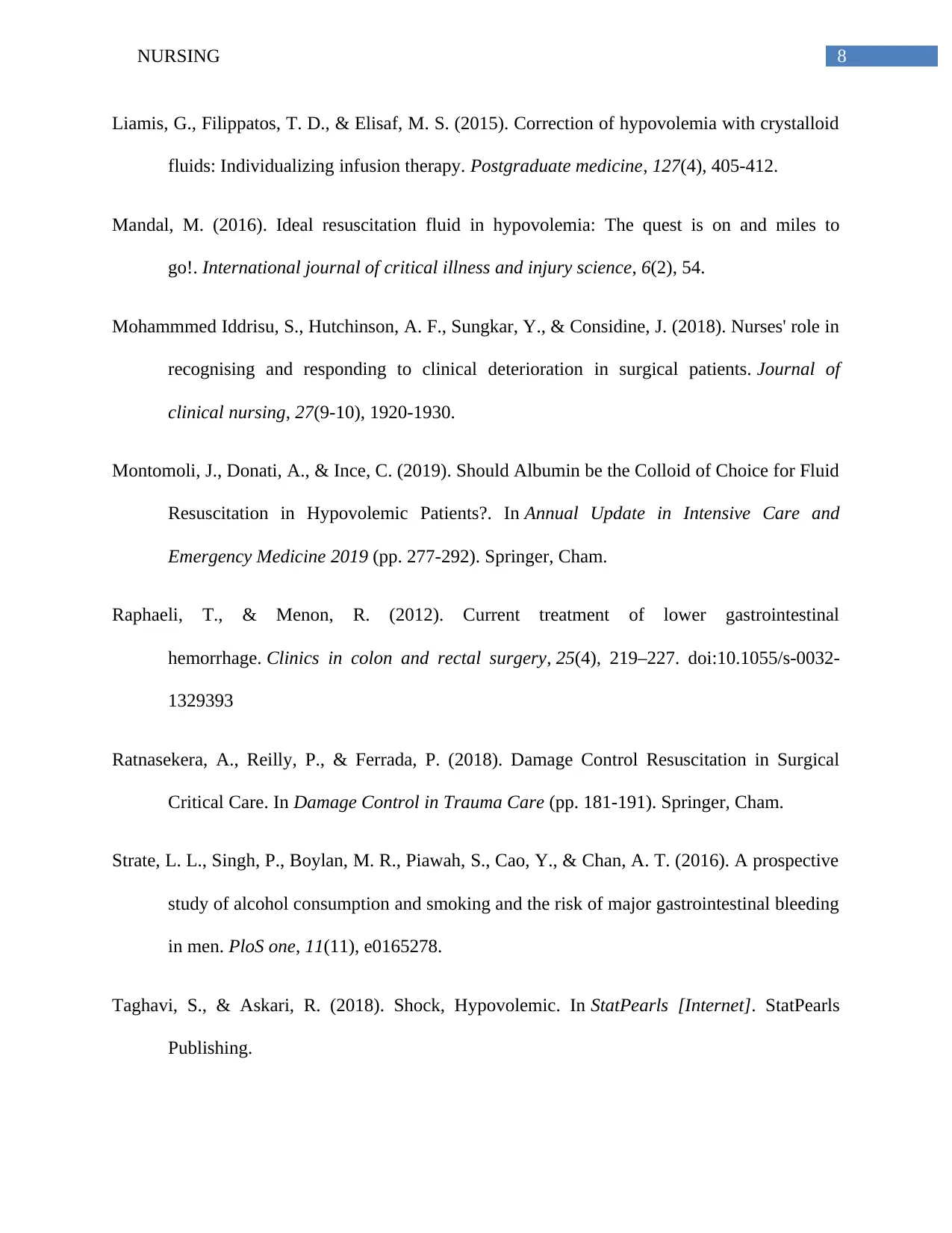
8NURSING
Liamis, G., Filippatos, T. D., & Elisaf, M. S. (2015). Correction of hypovolemia with crystalloid
fluids: Individualizing infusion therapy. Postgraduate medicine, 127(4), 405-412.
Mandal, M. (2016). Ideal resuscitation fluid in hypovolemia: The quest is on and miles to
go!. International journal of critical illness and injury science, 6(2), 54.
Mohammmed Iddrisu, S., Hutchinson, A. F., Sungkar, Y., & Considine, J. (2018). Nurses' role in
recognising and responding to clinical deterioration in surgical patients. Journal of
clinical nursing, 27(9-10), 1920-1930.
Montomoli, J., Donati, A., & Ince, C. (2019). Should Albumin be the Colloid of Choice for Fluid
Resuscitation in Hypovolemic Patients?. In Annual Update in Intensive Care and
Emergency Medicine 2019 (pp. 277-292). Springer, Cham.
Raphaeli, T., & Menon, R. (2012). Current treatment of lower gastrointestinal
hemorrhage. Clinics in colon and rectal surgery, 25(4), 219–227. doi:10.1055/s-0032-
1329393
Ratnasekera, A., Reilly, P., & Ferrada, P. (2018). Damage Control Resuscitation in Surgical
Critical Care. In Damage Control in Trauma Care (pp. 181-191). Springer, Cham.
Strate, L. L., Singh, P., Boylan, M. R., Piawah, S., Cao, Y., & Chan, A. T. (2016). A prospective
study of alcohol consumption and smoking and the risk of major gastrointestinal bleeding
in men. PloS one, 11(11), e0165278.
Taghavi, S., & Askari, R. (2018). Shock, Hypovolemic. In StatPearls [Internet]. StatPearls
Publishing.
Liamis, G., Filippatos, T. D., & Elisaf, M. S. (2015). Correction of hypovolemia with crystalloid
fluids: Individualizing infusion therapy. Postgraduate medicine, 127(4), 405-412.
Mandal, M. (2016). Ideal resuscitation fluid in hypovolemia: The quest is on and miles to
go!. International journal of critical illness and injury science, 6(2), 54.
Mohammmed Iddrisu, S., Hutchinson, A. F., Sungkar, Y., & Considine, J. (2018). Nurses' role in
recognising and responding to clinical deterioration in surgical patients. Journal of
clinical nursing, 27(9-10), 1920-1930.
Montomoli, J., Donati, A., & Ince, C. (2019). Should Albumin be the Colloid of Choice for Fluid
Resuscitation in Hypovolemic Patients?. In Annual Update in Intensive Care and
Emergency Medicine 2019 (pp. 277-292). Springer, Cham.
Raphaeli, T., & Menon, R. (2012). Current treatment of lower gastrointestinal
hemorrhage. Clinics in colon and rectal surgery, 25(4), 219–227. doi:10.1055/s-0032-
1329393
Ratnasekera, A., Reilly, P., & Ferrada, P. (2018). Damage Control Resuscitation in Surgical
Critical Care. In Damage Control in Trauma Care (pp. 181-191). Springer, Cham.
Strate, L. L., Singh, P., Boylan, M. R., Piawah, S., Cao, Y., & Chan, A. T. (2016). A prospective
study of alcohol consumption and smoking and the risk of major gastrointestinal bleeding
in men. PloS one, 11(11), e0165278.
Taghavi, S., & Askari, R. (2018). Shock, Hypovolemic. In StatPearls [Internet]. StatPearls
Publishing.
⊘ This is a preview!⊘
Do you want full access?
Subscribe today to unlock all pages.

Trusted by 1+ million students worldwide

9NURSING
Walley, K. R. (2018). Mitigating microvascular leak during fluid resuscitation of hemorrhagic
shock. Anesthesiology: The Journal of the American Society of Anesthesiologists, 128(2),
252-253.
World Health Organization (2019). The Clinical use of blood. Retrieved from:
https://www.who.int/bloodsafety/clinical_use/en/Handbook_EN.pdf
Walley, K. R. (2018). Mitigating microvascular leak during fluid resuscitation of hemorrhagic
shock. Anesthesiology: The Journal of the American Society of Anesthesiologists, 128(2),
252-253.
World Health Organization (2019). The Clinical use of blood. Retrieved from:
https://www.who.int/bloodsafety/clinical_use/en/Handbook_EN.pdf
Paraphrase This Document
Need a fresh take? Get an instant paraphrase of this document with our AI Paraphraser
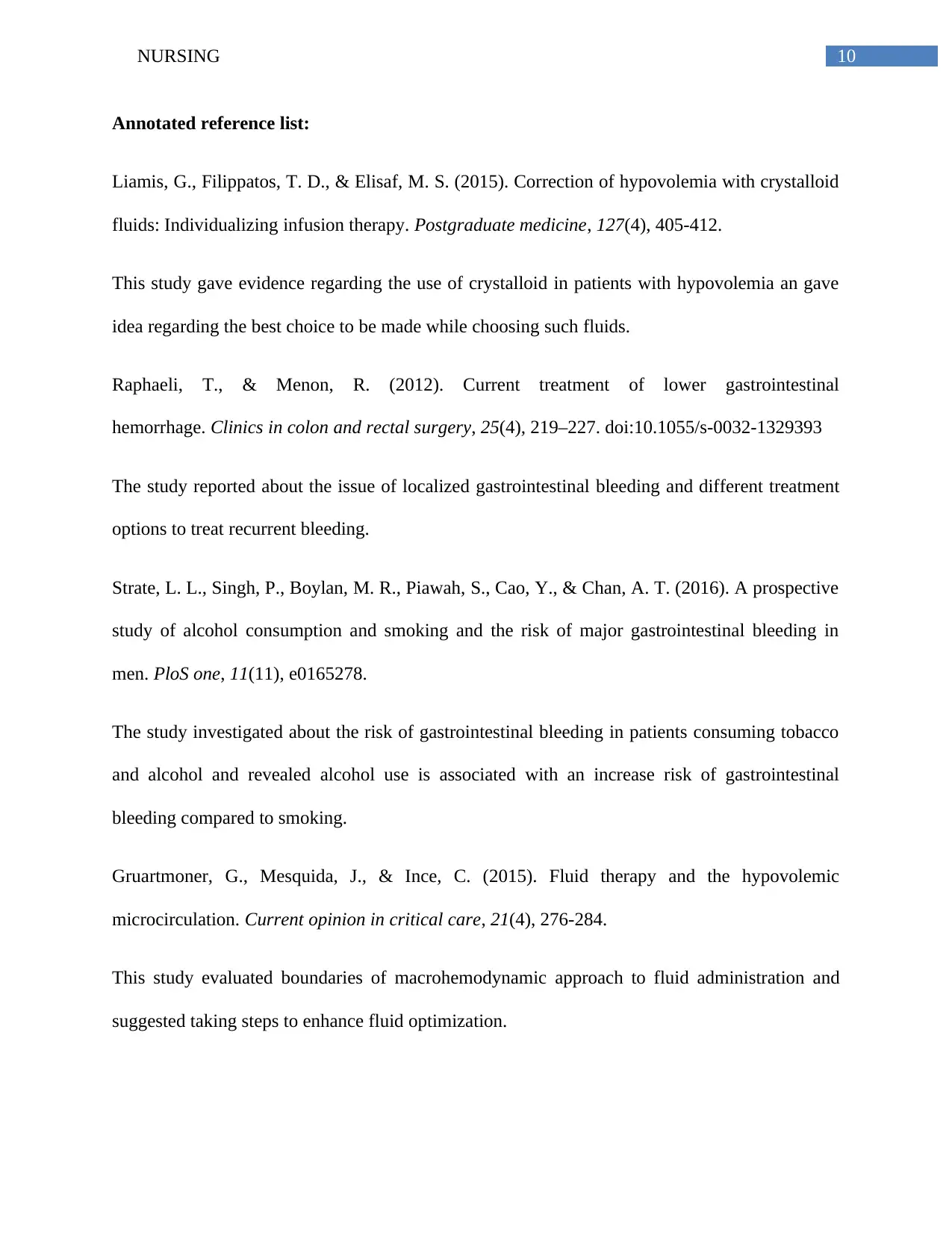
10NURSING
Annotated reference list:
Liamis, G., Filippatos, T. D., & Elisaf, M. S. (2015). Correction of hypovolemia with crystalloid
fluids: Individualizing infusion therapy. Postgraduate medicine, 127(4), 405-412.
This study gave evidence regarding the use of crystalloid in patients with hypovolemia an gave
idea regarding the best choice to be made while choosing such fluids.
Raphaeli, T., & Menon, R. (2012). Current treatment of lower gastrointestinal
hemorrhage. Clinics in colon and rectal surgery, 25(4), 219–227. doi:10.1055/s-0032-1329393
The study reported about the issue of localized gastrointestinal bleeding and different treatment
options to treat recurrent bleeding.
Strate, L. L., Singh, P., Boylan, M. R., Piawah, S., Cao, Y., & Chan, A. T. (2016). A prospective
study of alcohol consumption and smoking and the risk of major gastrointestinal bleeding in
men. PloS one, 11(11), e0165278.
The study investigated about the risk of gastrointestinal bleeding in patients consuming tobacco
and alcohol and revealed alcohol use is associated with an increase risk of gastrointestinal
bleeding compared to smoking.
Gruartmoner, G., Mesquida, J., & Ince, C. (2015). Fluid therapy and the hypovolemic
microcirculation. Current opinion in critical care, 21(4), 276-284.
This study evaluated boundaries of macrohemodynamic approach to fluid administration and
suggested taking steps to enhance fluid optimization.
Annotated reference list:
Liamis, G., Filippatos, T. D., & Elisaf, M. S. (2015). Correction of hypovolemia with crystalloid
fluids: Individualizing infusion therapy. Postgraduate medicine, 127(4), 405-412.
This study gave evidence regarding the use of crystalloid in patients with hypovolemia an gave
idea regarding the best choice to be made while choosing such fluids.
Raphaeli, T., & Menon, R. (2012). Current treatment of lower gastrointestinal
hemorrhage. Clinics in colon and rectal surgery, 25(4), 219–227. doi:10.1055/s-0032-1329393
The study reported about the issue of localized gastrointestinal bleeding and different treatment
options to treat recurrent bleeding.
Strate, L. L., Singh, P., Boylan, M. R., Piawah, S., Cao, Y., & Chan, A. T. (2016). A prospective
study of alcohol consumption and smoking and the risk of major gastrointestinal bleeding in
men. PloS one, 11(11), e0165278.
The study investigated about the risk of gastrointestinal bleeding in patients consuming tobacco
and alcohol and revealed alcohol use is associated with an increase risk of gastrointestinal
bleeding compared to smoking.
Gruartmoner, G., Mesquida, J., & Ince, C. (2015). Fluid therapy and the hypovolemic
microcirculation. Current opinion in critical care, 21(4), 276-284.
This study evaluated boundaries of macrohemodynamic approach to fluid administration and
suggested taking steps to enhance fluid optimization.

11NURSING
Montomoli, J., Donati, A., & Ince, C. (2019). Should Albumin be the Colloid of Choice for Fluid
Resuscitation in Hypovolemic Patients?. In Annual Update in Intensive Care and
Emergency Medicine 2019 (pp. 277-292). Springer, Cham.
This study demonstrates use of crystalloids as one dominant resuscitation fluid in patients with
hypovolemia.
Mandal, M. (2016). Ideal resuscitation fluid in hypovolemia: The quest is on and miles to
go!. International journal of critical illness and injury science, 6(2), 54.
The study gives idea about changes in patient with hypovolemic shocks and evidence regarding
treatments for such patient.
Feehally, J., & Khosravi, M. (2015). Effects of acute and chronic hypohydration on kidney
health and function. Nutrition reviews, 73(suppl_2), 110-119.
The study shows that as kidney plays a key role in homeostasis of body fluid, fluid depletion
issues should be immediately addressed to prevent kidney failure.
Raphaeli, T., & Menon, R. (2012). Current treatment of lower gastrointestinal
hemorrhage. Clinics in colon and rectal surgery, 25(4), 219–227. doi:10.1055/s-0032-
1329393
The study investigated about lower gastrointestinal bleeding and the steps to be taken to localize
the site of bleeding.
Montomoli, J., Donati, A., & Ince, C. (2019). Should Albumin be the Colloid of Choice for Fluid
Resuscitation in Hypovolemic Patients?. In Annual Update in Intensive Care and
Emergency Medicine 2019 (pp. 277-292). Springer, Cham.
This study demonstrates use of crystalloids as one dominant resuscitation fluid in patients with
hypovolemia.
Mandal, M. (2016). Ideal resuscitation fluid in hypovolemia: The quest is on and miles to
go!. International journal of critical illness and injury science, 6(2), 54.
The study gives idea about changes in patient with hypovolemic shocks and evidence regarding
treatments for such patient.
Feehally, J., & Khosravi, M. (2015). Effects of acute and chronic hypohydration on kidney
health and function. Nutrition reviews, 73(suppl_2), 110-119.
The study shows that as kidney plays a key role in homeostasis of body fluid, fluid depletion
issues should be immediately addressed to prevent kidney failure.
Raphaeli, T., & Menon, R. (2012). Current treatment of lower gastrointestinal
hemorrhage. Clinics in colon and rectal surgery, 25(4), 219–227. doi:10.1055/s-0032-
1329393
The study investigated about lower gastrointestinal bleeding and the steps to be taken to localize
the site of bleeding.
⊘ This is a preview!⊘
Do you want full access?
Subscribe today to unlock all pages.

Trusted by 1+ million students worldwide
1 out of 13
Related Documents
Your All-in-One AI-Powered Toolkit for Academic Success.
+13062052269
info@desklib.com
Available 24*7 on WhatsApp / Email
![[object Object]](/_next/static/media/star-bottom.7253800d.svg)
Unlock your academic potential
Copyright © 2020–2025 A2Z Services. All Rights Reserved. Developed and managed by ZUCOL.





